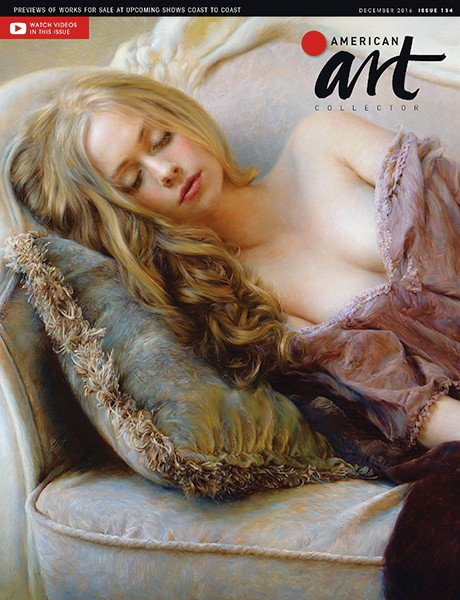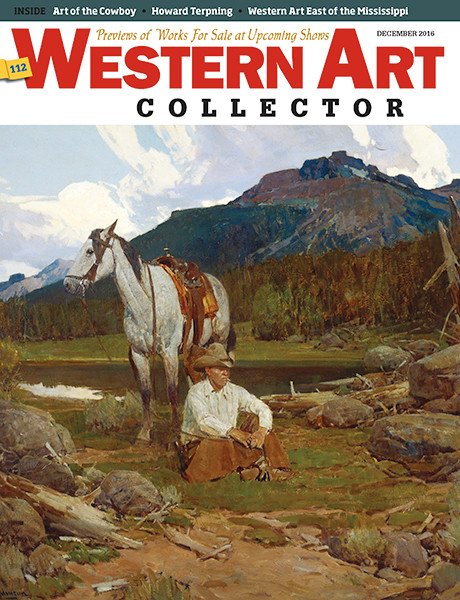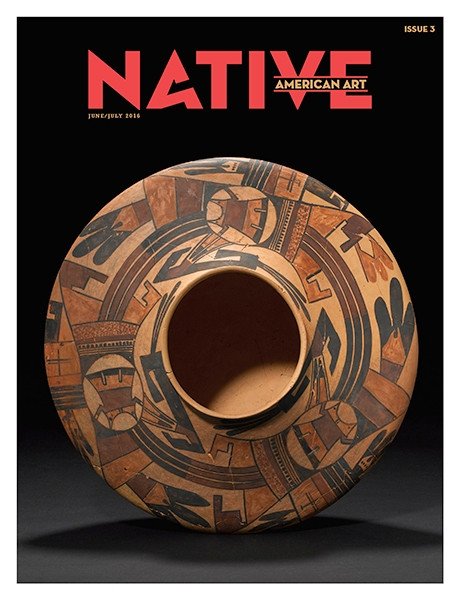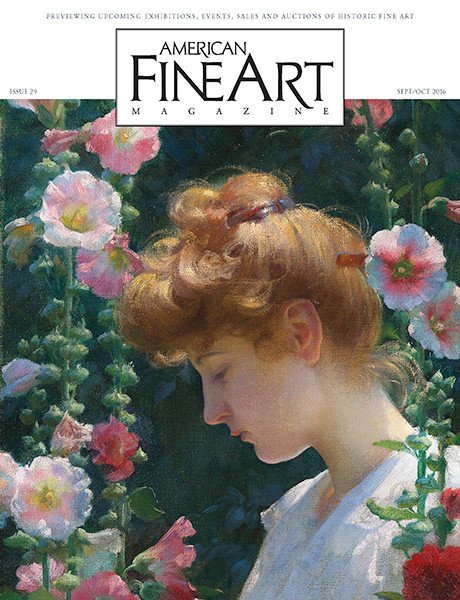For years I have painted portraits on historical documents relating to my family’s journey as Native Americans (Choctaw tribe). In 2016, these images were painted on my ancestors’ birth and marriage certificates, land title deeds and blood quantum registrations, also known as the Dawes Rolls. I was gratified to learn this information was embraced not only as art but also as a transformative learning experience. The series is called “A Choctaw Story of Land and Blood” and as the audience for my art grew, I realized very few people were aware of our shared history of forced assimilation and its implications in today’s world. It was then I decided I would bring today’s Native people into today’s narrative and focus on their inherent strength and beauty.

Scavenger Hunt, oil on paper, 24 x 24" (60 x 60 cm) (including frame)
In 2019 I created my first series of contemporary Native women portraits for the Year of the Woman. Soon afterwards I went on to create my current series, which is often done on maps. This series is really a marriage of the first two series: combining contemporary Native portraits with historical data. In constructing these portraits, I paint directly on documents that are more recognizable such as National Geographic maps. These portraits evolve spontaneously, and they are meant to reach the viewer on an emotional level. It is what I like to describe as contemporary ledger art.

Wild Wild West, oil on paper, 24 x 24" (60 x 60 cm) (including frame)

Land of Enchantment, oil on paper, 24 x 24" (60 x 60 cm) (including frame)
Many of my paintings are based upon the vibrant photographs of Matt Toledo, a talented Navajo photographer. The painting you see being created in the following pages is called Thanksgiving. It is of a young Navajo girl who lives in the area of the map she is now painted on. The basket she holds is part of her culture and is being presented as a gift. I love the fact I can paint people I know and allow their spirits to take center stage.
My Art in the Making Thanksgiving
 Stage 1
Stage 1
Stage 1 Preparation
Attaching maps to a solid, non-bendable surface works best for this process. I like using cradled birch painting panels in size 18 by 18”. They must be sanded first and free from surface imperfections. I use original maps, which come pre-folded. I press them open by laying them between a tabletop and a piece of glass covered with heavy books to help relax the folds. A warm iron can also be used with a light touch. I have three to four maps being pressed in my studio under glass for months before attempting to use them. Always briefly soak them in water immediately before gluing to your surface.
 Stage 2
Stage 2Stage 2 Adhering Your Map
I first apply a glue (Mod Podge) to the top of the birch panel. At the same time, I soak my map in tepid water for about 30 seconds and let the excess water drip off before carefully applying to the top of the prepared panel. This is easily accomplished in a bathtub. I then take a brayer and work on getting out all the air pockets. Strategically place any information on your map to your advantage. For example, I make sure “The Southwest” and the map title are viewable as it reinforces my theme.
When the top is nearly dry, I place a piece of glass on the panel to help it dry flat. When it is finally dry, I turn it upside down and use an X-Acto knife to cut off the edges. Pre-cut your map to about three inches larger than your panel before soaking it to make it more manageable. Be sure you have a brand new blade to avoid tearing the paper.
 Stage 3
Stage 3Stage 3 Creating a Transferable Image
I use a full-size black-and-white print-out for this step and print it out on thin 11 by 17" paper.
 Stage 4
Stage 4Stage 4 Placing Your Image
Before I transfer my image, I cut out the silhouette and trace around it onto the map. I paint in the silhouette with a light beige acrylic paint (an off-white is my preferred color). When it has dried, I am ready to transfer my image to the blank contours of the silhouette.
 Stage 5
Stage 5Stage 5 Transferring Your Image
I do not like to use graphite paper because it can sometimes show through the oil paint. Instead, I use a Cretacolor pastel crayon in a medium brown. Turning the printed image to the back side I cover it with the pastel crayon making sure to cover all the detail. I then use my finger to rub in the chalk. After applying the crayon, I place the cutout pastel side down onto the silhouette and transfer my reference lines by tracing over any details I feel necessary with a colored pencil. When I am done, I spray the map using Krylon satin spray varnish, which is acid free and allows easy rework. Try out your varnish on a scrap of your map first and let it dry. Make sure it works for your application.
 Stage 6
Stage 6Stage 6 Painting the Face
I start with the face, laying in a medium intensity and color (see color palette). Throughout the process I then add darks and lights to build out the features. At this stage I use a small amount of Liquin medium to facilitate paint application. Keep in mind painting on a map sometimes necessitates multiple layers as the paper tries to absorb any moisture. My color palette for this face uses varying degrees for medium to light values. The darkest values for the brows and eye lashes are achieved using a mixture of asphaltum or Van Dyke brown and violet dioxazine. I build these slowly and apply more paint as they inevitably sink into the paper backing.
 Stage 7
Stage 7Stage 7 The Shirt
I paint the shirt using a build-up of values and then add in details with darks and lights. I am using brown ochre, sap green and alizarin crimson. A light glaze of alizarin crimson/Van Dyke brown and violet dioxazine are added to the deepest values. In some areas I add a bit of diluted cadmium red medium for variation. At the same time, I use the flesh mixture to add in the hands.

Painting Dark Hair
Don’t use black. Start with a rough-in using browns and then develop the movement. Use a varying mixture of browns and purples to add layers, ending with highlights. Blue can also be helpful.
 Stage 8
Stage 8Stage 8 The Jewelry
When painting silver jewelry, I start with a medium gray by mixing white together with a blue and a brown. Most of the time this is ultramarine blue, Van Dyke brown and titanium white, but I find any shade of these three colors will do the trick. I then add in successive layers of light and dark versions of these three colors. The stones are fashioned with shades of orange, turquoise, violet and green.
 Stage 9
Stage 9Stage 9 The Basket
I paint in the basket building up the complexity of the design with progressively darker layers. I am careful to preserve the 3D nature of the appearance. Tip: When doing baskets, it’s important to have some diversity in your approach to keep the basket looking realistic. Keep the weaving uneven in areas to promote a 3D effect.
 Stage 10
Stage 10Stage 10 The Skirt and Aura
The skirt is painted in the same fashion, from dark to light using only three colors: alizarin crimson, titanium white and adding in a small amount of sap green for the darkest folds. I do not add too much detail as I want the viewer’s eyes to stay focused on the subject’s face as well as the basket she is holding. I decided to use burnt sienna mixed with Liquin around the girl’s head. I apply it thinly and blend it gently with a large flat brush to provide a light golden aura around her head. I am planning on adding a halo on top of this and want it to stand out from the background. Note: I have tested the burnt sienna application on a scrap of paper first.

Using an iPad as Reference
I find it extremely helpful to set up my iPad as a reference while painting. In doing this I can zoom into any area to see more detail. I can also enlarge the photo to set my caliper to a specific measurement to match my painting. Once I do this, it allows me to double check any part of my painting to see if my proportions are correct. Another advantage is being able to reduce the photo contrast to see the details not detectable in the reference photo.
 Stage 11
Stage 11Stage 11 The Halo
I position the halo using a round template. I trace it out using a light brown colored pencil, then apply Naples yellow mixed with titanium white mixed with Liquin. I keep it transparent enough to show the map in the background.
 Stage 12
Stage 12Stage 12 Painting in the Hair
Now that the halo is dry, I am ready to finish the hair. The hair is currently blocked in using asphaltum. I will now refine the strands with darker applications that incorporate violet dioxazine and Van Dyke brown. Highlights are achieved with white added to the hair mixture. Again, I darken the eyebrows and lashes to preserve the 3D nature of her gaze. When painting hair don’t use black. Start with a rough-in, using browns and develop the movement. Use a varying mixture of browns and purples to add layers (sometimes blue), ending with highlights.
 Stage 13
Stage 13Stage 13 Creating the Shadowbox Frame
Thanksgiving, oil on paper, 24 x 24" (60 x 60 cm) (including frame) When using deep wooden panels such as this one, I like to create my own frames. To make this frame, I buy the same panel in the next size up, which is 24-by-24”. This gives me a nice buffer around the painted 18-by-18” image, resulting in a matte-like approach. If you plan on staining your frame, do it before you proceed to the next steps. Stain the outer frame first, paint the inside of the frame (in this case green) and then attach your inside trim. For this frame I used a Maple Gell Stain on the outside frame and painted the inside of the frame a rich green. Before attaching the painting, I trimmed out the interior edges with ¼” strips of wood trim. They were then painted a blue/turquoise color and attached with Elmer’s Glue.
To attach my art, I first position it within the larger frame after it is painted. I then tape around the paintings’ edges and remove the painting. Next, I drill pilot holes approximately 1⁄2” in from the tape. I then glue the painted panel to the frame with Liquid Nail, lining up all four corners with my tape. When the glue is dry, I attach screws from the back side of the frame using the pilot holes I have already drilled. You now have a very secure mounting, and you are ready to attach a wire for hanging.





